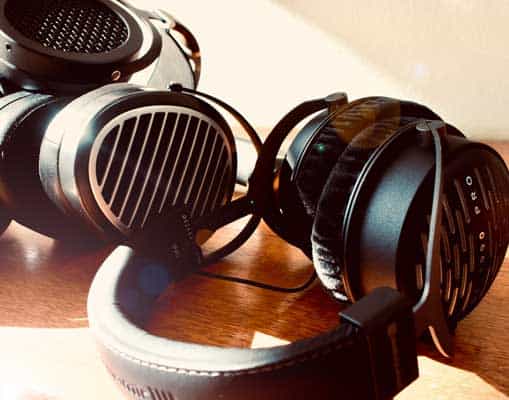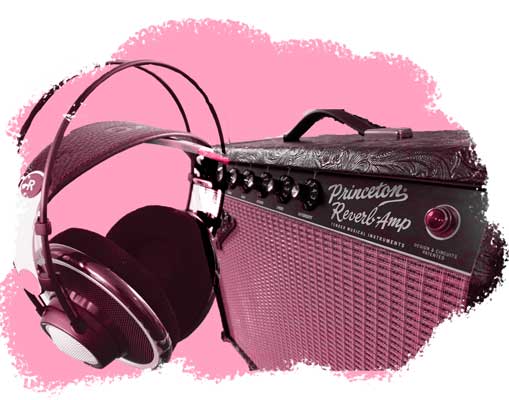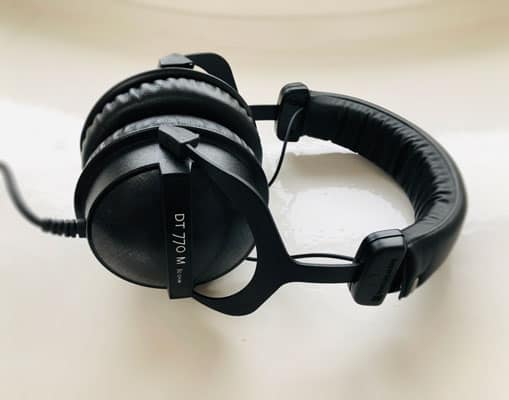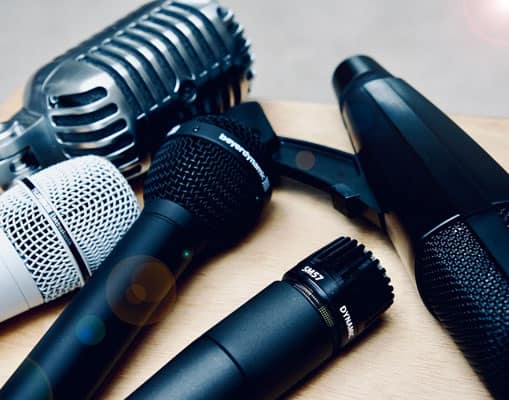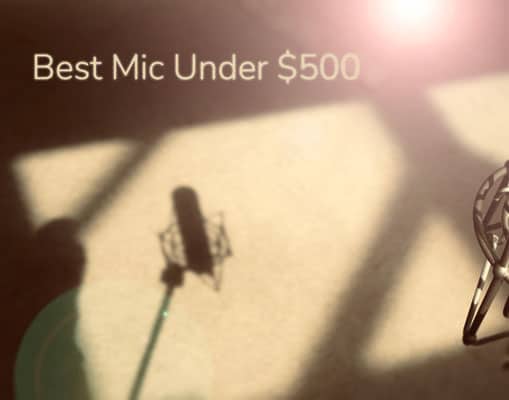What is transient response? Transient response in audio is the ability of a machine to recover from rapid level peaks in sound waves. It is often discussed when assessing the quality of speakers, headphones, or microphones.
What is a Transient? Why Should I care?
A transient is the burst of energy at the start of a sound that creates a peak in the audio waveform. It happens quickly. If you clap your hands or bump your microphone, an obvious transient occurs.
Here below we have four kicks from a kick drum as you might see in your DAW. The transient is the front of the waveform (bracketed in red). What follows the transient is its decay.
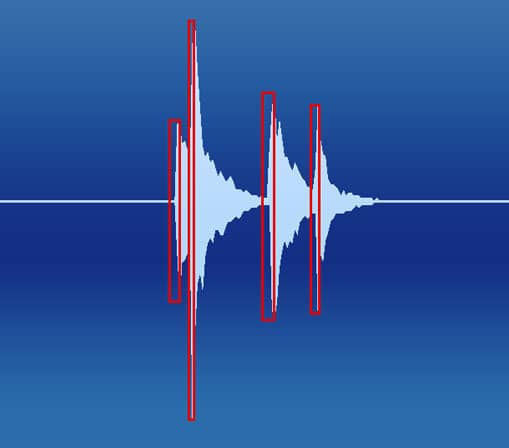
Some argue that disruptions in musical patterns, such as transients, correlate with emotional responses to music.
Engineers and producers have long, drawn-out, nerdy discussions on this topic for a reason: transient response can make the difference between an exciting musical experience and a dull one.
For more articles like this, check out our audio gear category page.
Transient Response in Speakers
Speakers give us the most visceral and visible manifestation of transient response. In fact, when you watch the cone of your speaker moving up and down, you can see its transient response with your eyes.
First, let’s discuss how speakers work to make the idea of transient response clearer.
How Speakers Work
Speakers work by converting an electrical signal into mechanical movement. This movement creates air pressure, or compressed air moving in waves. Our ears hear these waves as sound.
Just as a microphone picks up air pressure changes and converts them into electrical signals, a speaker is reversing this process, converting the electrical signal into changes in air pressure, or sound waves.
The Process: Converting Electrical Signals into Sound Waves
In a speaker, an electrical signal is sent into a coil of wire called the voice coil. The voice coil sits between the poles of a permanent magnet creating a magnetic field.
Magnetic fields have a polar orientation like a compass (a true ‘north’). By reversing the flow of the electrical current to the voice coil, north becomes south. When the voice coil’s polar orientation reverses, the coil moves back and forth as it pushes and pulls against the permanent magnet.
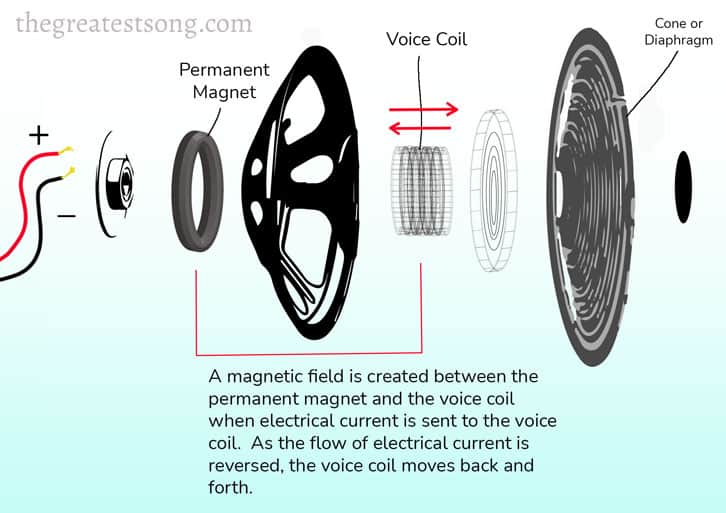
This movement, in turn, pushes and pulls the speaker’s cone (or diaphragm). By vibrating the air in front of the speaker, the cone produces air pressure. And with sound pressure comes the magic – sound waves!
The strength of the electrical signal determines the cone’s velocity and distance which results in different frequencies.
Speakers will often have several drivers per speaker to achieve the best performance across a wider frequency range. Different cone or driver sizes and shapes produce different frequencies – for example, woofers (larger cones) for bass, and tweeters (smaller cones) for high frequencies.
The quality of a speaker is determined by how accurately it can reproduce the changes in air pressure picked up by the microphone that recorded the sound in the first place. An ideal speaker reproduces these sound waves exactly with nothing added.
For accurate reproduction of sound, a speaker should be able to recover quickly from a sudden peak in the audio signal. That brings us back to our topic: transient response. This ability of a speaker to handle rapid signal changes is its transient response.
Because of inertia, most speakers will continue to travel (overshoot) past the signal level sent by the amplifier.
This overshoot adds distortion to the sound but also delays the time it will take for the speaker to settle back to neutral. This slow recovery creates a slower transient response time, resulting in less accurate reproduction.
Transient Response in Headphones
Headphones have fewer and smaller variables to deal with, and therefore, have an easier time producing an accurate transient response.
Most headphones use dynamic drivers (usually, one per ear), which are basically small speakers in your ears. They use the same voice-coil and magnet mechanism where the attached diaphragm that creates sound waves is a thin metal sheet. This entire mechanism is called a driver.
Headphones that use planar magnetic drivers or electrostatic drivers tend to have a quicker transient response as they have less mass that needs to settle after each transient.
To create a magnetic field, planar magnetic drivers are constructed with a an array of magnets and tiny wires spread across the diaphragm itself (planar magnetic coil).
Electrostatic drivers use only a diaphragm charged between two thin strips of metal resulting in even less total mass.
Transient Response in Microphones
Transient response in microphones occurs on the receiving end of the process. Air pressure creates sound waves which vibrate the diaphragm of a microphone. This movement is recorded and converted into an electrical signal.
Rapid shifts in air pressure create transients and the mic must be able to recover quickly to record the sound waves accurately.
Condenser microphones respond faster to transients because the innards used to record have less mass. The only bit that needs to move for the measurement to occur is the thin metal diaphragm. (See Types of Microphones & How They Work)
Dynamic microphones, on the other hand, need to move a coil and diaphragm to make the measurement resulting in a slower response time.
High-frequency sounds tend to produce sharper transients. This is why small diaphragm condensers are the preferred choice to capture the detail of acoustic instruments like a guitar or violin.
Quicker Transient Response is Not Always Better in Mics
Faster transient response in speakers and headphones is almost always better. But with microphones, this is not always the case.
For example, ribbon microphones take a lot more time to settle after a transient. As the ribbon diaphragm wabbles back and forth, the slower transient response can soften the harshness of cymbals or some vocals.
Small diaphragm condenser mics deliver the fastest transients. Large diaphragm condensers, due to the larger size, compress transients slightly and sometimes blend into one another. This can give satisfying ‘warmer’ results.
In the case of microphones, trust your ears, not the numbers.
Questions or Comments?
Join the discussion here on Facebook.
